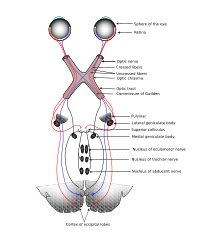
Photo from wikipedia
BACKGROUND Ca2+ influx plays an essential role in the physiological and pathophysiologic processes of several nervous system diseases. The transient receptor-potential channels (TRPCs) form a family of voltage -sensitive calcium… Click to show full abstract
BACKGROUND Ca2+ influx plays an essential role in the physiological and pathophysiologic processes of several nervous system diseases. The transient receptor-potential channels (TRPCs) form a family of voltage -sensitive calcium ion channels. OBJECTIVE In this review, we will discuss the importance of transient receptor potential canonical (TRPC) channels, which is a crucial family of calcium channels. This article reviews the role of TRPC channels in the pathogenesis of diseases such as brain hemorrhage, hemorrhagic transformation after cerebral infarction, subarachnoid hemorrhage, and brain injury. RESULTS TRPC has especially high expression in the central nervous system (CNS), and was involved in several physiological functions. The TRPC family is associated with cerebral vasospasm after subarachnoid hemorrhage, neuronal damage after intracerebral hemorrhage, NMDA cytotoxicity in cerebral ischemia, nervous system tumors, neurodegenerative diseases, neural addiction and other diseases. CONCLUSION The TRPC family has rich functionality and is widely distributed, with different functions in various nervous system diseases.
Journal Title: Current drug targets
Year Published: 2017
Link to full text (if available)
Share on Social Media: Sign Up to like & get
recommendations!